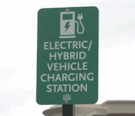Low coolant symbol In a previous post, we congratulated Kia for recycling a diesel symbol for use in an electrical vehicle (EV) to describe a similar job, rather than invent something new, which would add to the mountain of symbols that already exist. Here, we get to congratulate them again with a low coolant symbol. …
Author's posts
Permanent link to this article: https://dashboardsymbols.com/2024/09/low-coolant-symbol-recycled-for-electrical-equipment/
An EV using a glow plug indicator?
Glow plug indicator While updating our Kia dashboard symbols page, we came across something strange, or so it seemed initially. The EV 6 model uses a diesel engine glow plug indicator! Well this made absolutely no sense! However, digging deeper it turns out that the light is actually used to indicate that the electric vehicle’s …
Permanent link to this article: https://dashboardsymbols.com/2024/09/an-ev-using-a-glow-plug-indicator/
EV or gas? A little something to help you decide
EV or gas I had two conversations recently, back-to-back, that really came down EV or gas. Bear in mind, I drive an electric vehicle or EV. The first was with a waitress I’ve known for some time but hadn’t seen in a while and her “car story” that I’d thus missed. It seems her 5-year …
Permanent link to this article: https://dashboardsymbols.com/2024/09/ev-or-gas-a-little-something-to-help-you-decide/
Its got to be the plug. Its about the plug!
About the plug A friend passed along a New York Times article titled Should I Get a Hybrid or Go Full Electric? The title is linked. After reading it, and combined with additional information that was already running around my head, I emailed him back remarking that its all about the plug! Two hybrids The …
Permanent link to this article: https://dashboardsymbols.com/2024/09/its-got-to-be-the-plug-its-about-the-plug/
We added a new video to our YouTube channel: Replace the battery in a 2019 and later Kia key fob
Replace the battery in a Kia key fob We have added a video to our YouTube channel demonstrating how to replace the battery in a 2019 and later Kia key fob with a fresh one. The mechanical key comes in handy to remove the back of the key fob, and we also use a very …
Permanent link to this article: https://dashboardsymbols.com/2024/09/we-added-a-new-video-to-our-youtube-channel-replace-the-battery-in-a-2019-and-later-kia-key-fob/
Hyundai, Kia, Genesis back up entry page overhaul first step is done
Back up entry page overhaul We just completed the first step of a Hyundai, Kia, and Genesis back up entry page overhaul. The intent is to separate the three manufacturers who now have way too many back up entry processes. As that first step, we separated Genesis, admittedly the simplest of the three. Overall, the …
Permanent link to this article: https://dashboardsymbols.com/2024/09/hyundai-kia-genesis-back-up-entry-page-overhaul-first-step-is-done/
Open a Genesis with a Dead Key Fob
How to Open a Genesis with a Dead Key Fob First, if you are already inside, click here for help getting started! Second, you can find video help here! Finally, if you need or want another manufacturer, click here. Retrieving the mechanical key To use the most common Genesis key fob, press and hold the …
Permanent link to this article: https://dashboardsymbols.com/2024/09/open-a-genesis-with-a-dead-key-fob/



Marc Favreau
The author has 30+ years of automotive experience and has assembled the most extensive collection of symbols and warning lights anywhere (over 1,000!) and can help you open and start any keyless start car with a dead key fob battery. BA, St. Joseph's, ME: MS, RPI, NY
Most commented posts